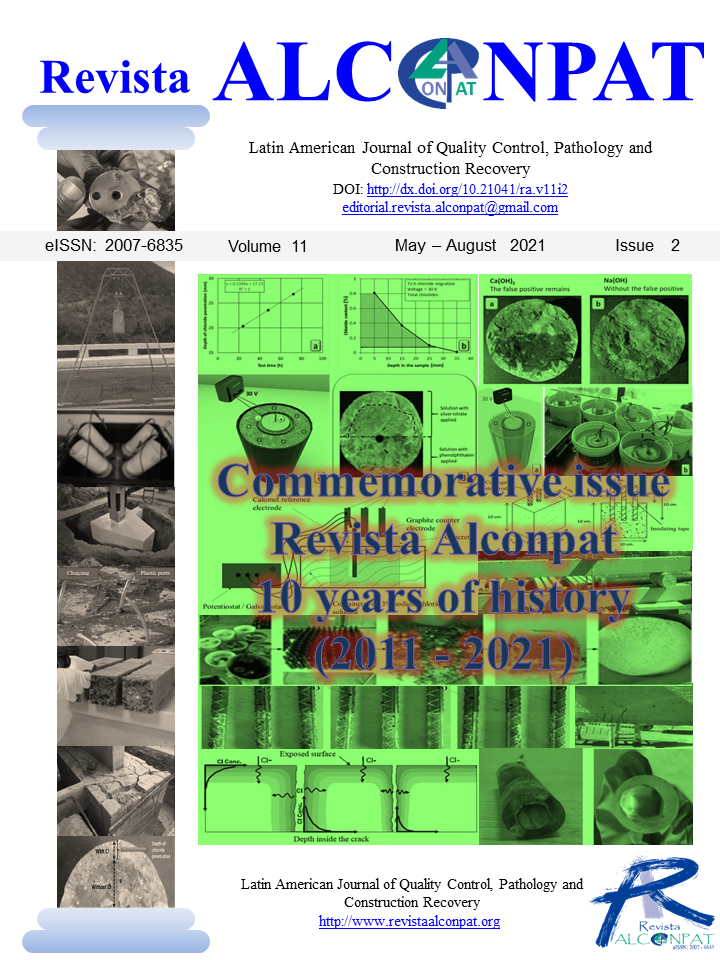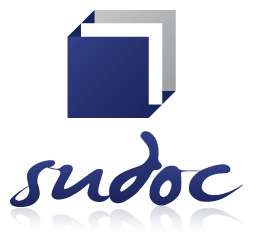RAV11N2, Message from the Editor in Chief (May - August, 2021)
Keywords:
--Abstract
JOURNAL OF THE LATIN-AMERICAN ASSOCIATION OF QUALITY CONTROL, PATHOLOGY AND RECOVERY OF CONSTRUCTION
http://www.revistaalconpat.org
With great satisfaction, we present the second issue of the eleventh year of the ALCONPAT Journal.
The objective of the Journal is the publication of contributions on basic or applied research directly related to solving problems about quality control, pathology and recovery of constructions, with related case studies being welcome in these areas.
This V11N2 edition begins with a work from Brazil, where Heber M. Paula and colleagues evaluate the incorporation of plant biomass ash, eucalyptus chips (ECA), sugarcane bagasse (SCBA) and rice husks (RHA), in mixed cement and lime mortars, considering their properties and mechanical performance. The mix by volume was 1: 1: 6, for a partial replacement of Portland cement with a content of 15 and 30%. The tests for the residues were for the characterization of the particles and pozzolanic activity, while the mortars were subjected to analysis in the fresh and hardened state. From the results obtained, the pretreatments (sieving and grinding) and the lime added to the mixture improved the reactivity of the ashes. The best performance was presented for mortars with 15% substitution, mainly for those containing RHA.
In the second work, from Brazil, Milton Paulino Costa Junior and S. M. M. Pinheiro verify the relationship between the action of loads that induce cracks and the durability of reinforced concrete. Prismatic test models (specimens) were produced and for two years these samples were subjected to artificial salt spray, under the action of a permanent central load, short-term central load without load (reference), with a 7-day cure. Chloride penetration tests and microstructural analyzes were performed, in addition to crack mapping. It was found that the load did not influence the chloride penetration results, however, it is observed that the micrographs and microanalysis show a formation of deterioration products and possible microorganisms, in comparison with the test tubes that did not suffer load.
The third work in this issue is from Mexico, where Jorge Uruchurtu-ChavarÃn and colleagues analyze the performance of reinforced concrete (RC) against corrosion, applying a chitosan coating to the rod. The specimens were prepared with different amounts of chitosan using solvents of apple cider vinegar, acetic acid, and sugar cane alcohol vinegar, and were subjected to electrochemical tests of polarization curves (PC), half-cell potential (HCP), electrochemical noise (EN) and linear polarization resistance (LPR). The amount of chitosan and optimal layers (thickness) were determined with an improvement in the protective properties, and low corrosion rates were obtained from concrete exposed to chlorides for 200 days. Preservation of coating on steel in concrete turns out to be interesting for future studies.
In the fourth article from Brazil, Fernanda Giannotti da Silva Ferreira and colleagues studied the incorporation of glass powder into conventional concrete for its influence on mechanical strength and durability. The objective of this work was to validate the durability of ultra high-performance cementitious compounds (CCUAD) with partial replacement of cement by finely ground glass, through the chloride migration test, using the NT Build 492 method. Specimens containing values of 0%, 10%, 20%, 30% and 50% of glass powder in relation to the volume of cement were evaluated 28 days of age. The results indicated that, with low values, the glass powder does not impair the properties of the composites and, at higher levels, the composites maintain adequate mechanical characteristics and durability.
The fifth article, by Giovana Costa Reus and colleagues, comes from Brazil and its main objective is to propose a standard procedure that enables the use of the colorimetric method to measure the depth of chloride penetration during inspections of concrete structures exposed to both chlorides and to carbonation. To avoid the occurrence of "false positive" results, solutions of calcium hydroxide (Ca (OH) â‚‚) and sodium hydroxide (NaOH) were tested as pretreatment. The tests were carried out on carbonated only samples, and on carbonate and chloride contaminated samples. The results showed that the NaOH solution eliminates carbonation interference. Therefore, a suitable method was arrived at for entering chloride contamination depth readings in field inspections of concrete structures.
The sixth work of this issue is written by Gilberto Ramos-Torres and colleagues from Mexico. They discuss the method of the elastic invariant of stiffness that allows obtaining the mechanical response of the bridge superstructure; it is based on the impact response of known masses applied to the center of the span to obtain the maximum displacement that defines the point stiffness. This is compared with the values of the curve formed with the stiffness invariants, constructed from the design characteristics of the bridge. The method was implemented in two bridges located on federal highway No. 14 of the State of Sonora Mex., with results consistent with the damage reported. The evaluation was qualitative from a global parameter, obtained in environmental conditions in the absence of wind and at constant temperature, suitable for the diagnosis of the present structural state, having limitations in skewed bridges.
In the seventh work, from Brazil, Guilherme Da Silva Munhoz and colleagues verified the fatigue safety of a bridge designed in 1987 according to current Brazilian regulations. A structural model was built to determine and verify the most critical section considering the Brazilian standard model and the vehicle spectrum in the literature. According to the stress variation method, it was concluded that the concrete subjected to compression meets the criteria, but the steel section is not sufficient to resist the shear and bending stresses. By the Palmgren-Miner rule, the fatigue life of the reinforcement subjected to bending is 13.91 years. A more detailed analysis of the structure and the load spectrum is necessary to confirm these results.
In the eighth work, from Brazil, Cristiane Santana da Silva and colleagues do a documentary investigation on the alkali / aggregate reaction (AAR) that has affected many foundations, which indicates the importance of carrying out a verification of the recovery procedures, which is carried out on fifty foundations. The objective was to build a profile of the recovery processes through a consultation with inspection companies or recovery executors in the city of Recife and neighboring cities. For this, a questionnaire with seventeen questions was applied methodologically. These results allowed to establish the similarities of the affected foundations, the diagnosis, the processes applied in the recovery, the advances in materials, the conditions for the use of the reinforcement, the costs, and allowed to identify the foundations that left an inspection window for additional controls. The result was an evaluation of the treatments in the bases affected by the AAR chemical reaction.
The article that closes the edition is by Pedro Castro Borges from Mexico and the Editorial Board of the Alconpat Journal. The objective of this article is to present to the community the achievements and challenges to come of the Alconpat Journal in its first ten years of existence. A narration was made of: how the idea of ​​having a scientific / technical journal at Alconpat International came about; when, how and where the discussions and the project took place; the implementation, the first issue, the punctuality; the requirements and challenges to meet for the first indexations (Scielo México, Scielo WoS, Redalyc, Latindex, Google); the Conacyt projects that made it possible to gradually meet the requirements for eventual applications at higher indexes (Scopus and WoS), repositories, directories (DOAJ) and super servers; electronic markings, publication in three languages ​​(Spanish, Portuguese and English), administrative times for every specific issue, etc. In the end, an extensive thanks are extended to all those who have participated in these initial 10 years and the program of activities for the academic celebration, held on May 19, 2021 in virtual mode, was added for posterity.
We are confident that the articles in this issue will constitute an important reference for those readers involved with questions of evaluations and characterizations of materials, elements, and structures. We thank the authors participating in this issue for their willingness and effort to present quality articles and meet the established deadlines.
On behalf of the Editorial Board
Pedro Castro Borges
Editor in Chief
Downloads
References
--
Downloads
Published
How to Cite
Issue
Section
License
_______________________________
License in effect from September 2020
You are free to:
- Share — copy and redistribute the material in any medium or format for any purpose, even commercially.
- Adapt — remix, transform, and build upon the material for any purpose, even commercially.
- The licensor cannot revoke these freedoms as long as you follow the license terms.
Under the following terms:
- Attribution — You must give appropriate credit , provide a link to the license, and indicate if changes were made . You may do so in any reasonable manner, but not in any way that suggests the licensor endorses you or your use.
- No additional restrictions — You may not apply legal terms or technological measures that legally restrict others from doing anything the license permits.
Notices:
You do not have to comply with the license for elements of the material in the public domain or where your use is permitted by an applicable exception or limitation .
No warranties are given. The license may not give you all of the permissions necessary for your intended use. For example, other rights such as publicity, privacy, or moral rights may limit how you use the material.

















.png)














